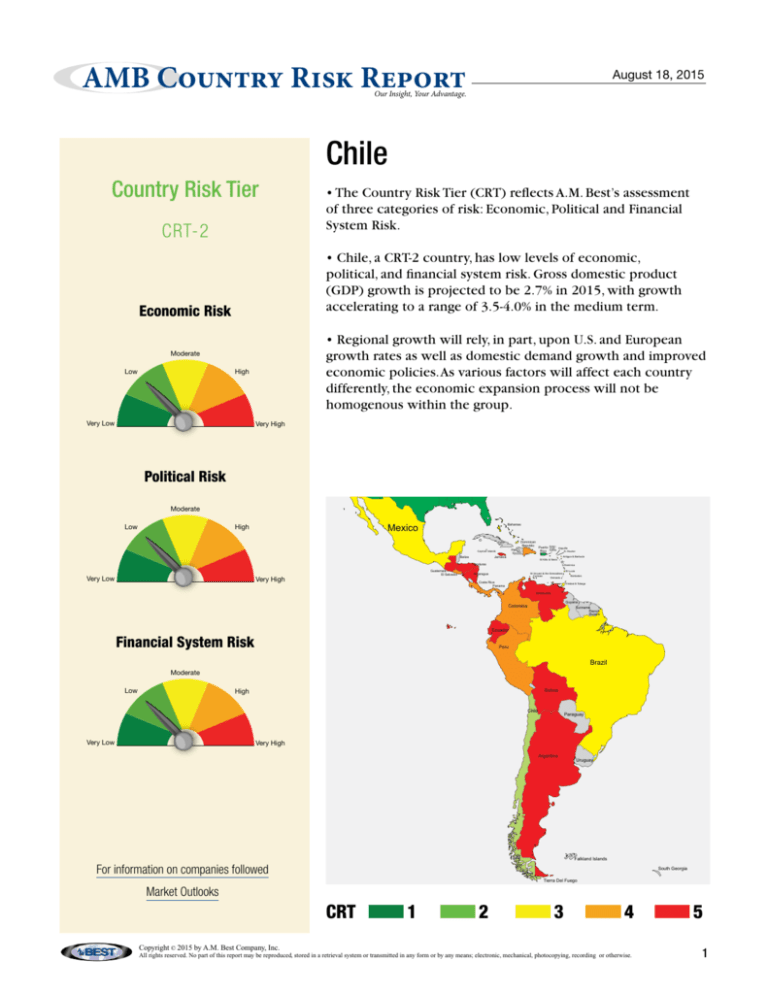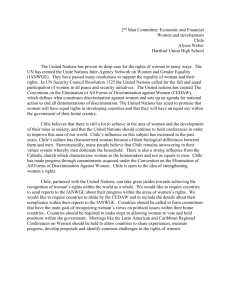
AMB Country Risk Report
August 18, 2015
Our Insight, Your Advantage.
Chile
Country Risk Tier
CRT-2
• Chile, a CRT-2 country, has low levels of economic,
political, and financial system risk. Gross domestic product
(GDP) growth is projected to be 2.7% in 2015, with growth
accelerating to a range of 3.5-4.0% in the medium term.
Economic Risk
Iceland
Greenland
• Regional growth will rely, in part, upon U.S. and European
growth rates as well as domestic demand growth and improved
economic policies. As various factors will affect each country
differently,
Canada the economic expansion process will not be
homogenous within the group.
Moderate
Low
• The Country Risk Tier (CRT) reflects A.M. Best’s assessment
of three categories of risk: Economic, Political and Financial
System Risk.
High
Very Low
Isle of Man
Irela
Guern
Je
Very High
United States
Political Risk
Gibraltar
Mexico
High
Bahamas
Western Sah
(Occupied by Moro
Dominican
Republic
Cuba
Puerto
Rico
Haiti
Cayman Islands
Belize
Jamaica
British
Virgin Anguilla
Islands
St. Maarten
St Kitts & Nevis
Honduras
Very Low
Very High
Guatemala
El Salvador
Mauritania
Antigua & Barbuda
Cape Verde
Dominica
Nicaragua
St Vincent & the Grenadines
Curacao
Grenada
Costa Rica
Panama
St Lucia
Guinea-Bissau
Guinea
Sierra
Leone
Guyana
Colombia
Liberi
Suriname
French
Guiana
Ecuador
Financial System Risk
Peru
Brazil
Moderate
High
Bolivia
Chile
Very Low
Paraguay
Very High
Argentina
For information on companies followed
Senegal
Gambia
Barbados
Trinidad & Tobago
Venezuela
Low
M
Canary
Islands
Moderate
Low
Portugal
Azores
Uruguay
Falkland Islands
South Georgia
Tierra Del Fuego
Market Outlooks
CRT 1 2 3 4 5
Copyright © 2015 by A.M. Best Company, Inc.
All rights reserved. No part of this report may be reproduced, stored in a retrieval system or transmitted in any form or by any means; electronic, mechanical, photocopying, recording or otherwise.
1
AMB Country Risk Report
Chile
Regional Summary: Latin America
Vital Statistics 2014
• Economic expansion in Latin America is
expected to decline in 2015, before staging
a moderate recovery in 2016.Weakness
in the region is largely concentrated with
commodity exporters where falling global
commodity prices have compounded
country specific challenges.
• Macroeconomic challenges affecting
the region include exchange rate volatility,
currency depreciation, the potential
consequences from the normalization
of U.S. monetary policy and the need to
address structural problems in order to
raise investment and job growth.
• Access to capital markets and the cost of
financing varies widely across the region.
Nominal GDP
Population
GDP Per Capita
Real GDP Growth
Inflation Rate
Premiums Written (Life)
Premiums Written (Non-Life)
Premiums Growth (2013 - 2014)
USD bn
mil
USD
%
%
USD mil
USD mil
%
257.97
17.8
14,477
1.8
4.4
6,401
4,513
-6.8
Regional Comparison
Country Risk Tier
CRT-2
CRT-5
CRT-3
CRT-4
CRT-4
CRT-5
Chile
Argentina
Brazil
Colombia
Peru
Venezuela
Source: IMF, Axco, Swiss Re and A.M. Best
• While governments vary widely across
the region, they all deal with a moderate
amount of corruption and the need
for improved transparency. Increased
and improved government regulation
and enforcement in recent years has
attempted to combat these issues.
Economic Growth
Economic Risk: Low
• Chile is endowed with natural resources
that include rich mineral deposits.The
country is the world’s number one
producer of cooper and iodine, and a
substantial producer of gold and silver.
The large decline in cooper prices over
the last few years has led to reduced
investment from mining companies.
• Inflation is projected at 3% for 2015,
largely as a result of lower commodity
and energy prices.This will bring inflation
in line with central bank targets.
• Economic growth in 2015 will be
driven by increased public spending and
stronger external demand for industrial
goods from the United States and Europe.
10
Real GDP
CPI Inflation
8
6
%
4
2
0
2006
2007
2008
2009
2010
2011
2012
2013
2014
2015
2016
2017
2018
2019
2020
-2
Source: IMF World Economic Outlook and A.M. Best
2
AMB Country Risk Report
Chile
Political Risk: Low
Political Risk Summary
• President Bachelet’s second term
will continue to implement reforms
aimed at improving social standards
in areas such as labor and health, with
a special emphasis of education. The
ruling coalition maintains a majority in
Congress, which enables the passing such
the legislation.
Score 1 (best) to 5 (worst)
Chile
World Average
International Transactions
Policy
5
4
Legal System
Monetary Policy
3
2
1
Regional Stability
• A challenge for the government
going forward will be to address
social inequalities while maintaining
a business friendly environment and
investor confidence.
Fiscal Policy
0
Social Stability
Business Environment
Government Stability
• Chile’s government has adhered to
prudent public finance management
practices that have kept public debt and
recent budget deficits under control.
Labor Flexibility
Source: A.M. Best
• Several corruption cases have put the
government under pressure to increase
transparency and restore confidence.The
cases relate to alleged illegal campaign
financing to politicians. In response, the
government has announced several anticorruption measures.
GDP Per Capita and Population
for Selected Countries
250
16,000
GDP Per Capita
Population
• Civil unrest, highlighted by protests
by students, trade groups and
indigenous organizations remains an
ongoing challenge.
14,000
200
12,000
Financial System Risk: Low
150
Millions
USD
10,000
8,000
100
6,000
4,000
50
2,000
0
Chile
Argentina
Source: IMF and A.M. Best
Brazil
Colombia
Peru
Venezuela
0
• The Superintendency of Securities
and Insurance is the insurance
supervisory authority.
• Chile’s financial sector is among the
most developed and stable in the region.
The legal framework and enforcement is
largely impartial and professional.
• Chile ranks #41 out of 189 countries
in the World Bank’s 2015 Doing
Business survey.
3
AMB Country Risk Report
Chile
GUIDE TO BEST’S COUnTry rISk TIErS
A.M. Best defines country risk as the risk that country-specific factors could adversely affect the claims-paying ability of an insurer. Country risk is
evaluated and factored into all Best’s Credit Ratings. Countries are placed into one of five tiers, ranging from “CRT-1” (Country Risk Tier 1), denoting
a stable environment with the least amount of risk, to “CRT-5” (Country Risk Tier 5) for countries that pose the most risk and, therefore, the greatest
challenge to an insurer’s financial stability, strength and performance.
A.M. Best’s Country Risk Tiers are not credit ratings and are not directly comparable to a sovereign debt rating, which evaluates the ability and
willingness of a government to service its debt obligations.
Country risk Tiers
Country risk Tier
Definition
CRT-1
Predictable and transparent legal environment, legal system and business infrastructure; sophisticated financial
system regulation with deep capital markets; mature insurance industry framework.
CRT-2
Predictable and transparent legal environment, legal system and business infrastructure; sufficient financial system
regulation; mature insurance industry framework.
CRT-3
Developing legal environment, legal system and business environment with developing capital markets; developing
insurance regulatory structure.
CRT-4
Relatively unpredictable and nontransparent political, legal and business environment with underdeveloped capital
markets; partially to fully inadequate regulatory structure.
CRT-5
Unpredictable and opaque political, legal and business environment with limited or nonexistent capital markets; low
human development and social instability; nascent insurance industry.
Country risk reports
A.M. Best Country Risk Reports are designed to provide a brief, high-level explanation of some of the key factors that determine a country’s Country
Risk Tier assignment. It is not intended to summarize A.M. Best’s opinion on any particular insurance market or the prospects for that market.
Categories of risk
Country Risk Reports provide scores for three categories of risk for each country. These scores are (1) Very Low; (2) Low; (3) Moderate; (4) High
and (5) Very High.
Category of risk
Definition
Economic Risk
The likelihood that fundamental weaknesses in a country’s economy will cause adverse developments for an insurer.
A.M. Best’s assessment of economic risk evaluates the state of the domestic economy, government finances and
international transactions, as well as prospects for growth and stability.
Political Risk
The likelihood that government or bureaucratic inefficiencies, societal tensions, inadequate legal system or
international tensions will cause adverse developments for an insurer. Political risk comprises the stability of the
government and society, the effectiveness of international diplomatic relationships, the reliability and integrity
of the legal system and of the business infrastructure, the efficiency of the government bureaucracy, and the
appropriateness and effectiveness of the government’s economic policies.
Financial System Risk
Financial system risk (which includes both insurance and non-insurance financial system risk) is the risk that financial
volatility may erupt due to inadequate reporting standards, weak banking system or asset markets, and/or poor
regulatory structure. In addition, it includes an evaluation of whether the insurance industry’s level of development and
public awareness, transparent and effective regulation and reporting standards, and sophisticated regulatory body will
contribute to a volatile financial system and compromise the ability of an insurer to pay claims.
Political risk Summary
To provide additional detail on the political risk in a given domicile the Country Risk Reports include the Political Risk Summary. The Political Risk
Summary is a radar chart that displays scores for nine different aspects of political risk scored on a scale of one to five with one being the least
amount of risk and five being the highest amount of risk.
Category
Definition
International Transactions
Policy
Measures the effectiveness of the exchange rate regime and currency management.
Monetary Policy
Measures the ability of a country to effectively implement monetary policy.
Fiscal Policy
Measures the ability of a country to effectively implement fiscal policy.
Business Environment
Measures the overall quality of the business environment and ease of doing business.
Labor Flexibility
Measures the flexibility of the labor market, including the company’s ability to hire and fire employees.
Government Stability
Measures the degree of stability in a government.
Social Stability
Measures the degree of social stability, including human development and political rights.
Regional Stability
Measures the degree of stability in the region.
Legal System
Measures the transparency and level of corruption in the legal system.
Country risk Tier Disclosure
A Country Risk Tier (CRT) is not a credit rating, rather it represents a component of A.M. Best’s Credit Rating Methodology that is applied to all
insurers. A CRT is not a recommendation to purchase, hold or terminate any security, insurance policy, contract or any other financial obligation
issued by a government, an insurer or other rated issuer, nor does it address the suitability of any particular policy, contract or other financial
obligation for a specific purpose or purchaser.
Copyright © 2015 by A.M. Best Company, Inc.
Version 091714
Copyright © 2015 by A.M. Best Company, Inc.
All rights reserved. No part of this report may be reproduced, stored in a retrieval system or transmitted in any form or by any means; electronic, mechanical, photocopying, recording or otherwise.
4









